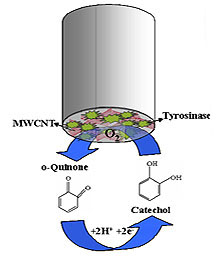Ecological biosensors

Over the last decade, the biosensors for environmental surveillance became more prevalent in literature with the emphasis to phenol determination and control. Phenols are compounds of large scale production that cause ecologically undesirable effects. Most phenols exhibit different toxicities and their determination are very important for evaluating the total toxicity of an environmental sample. In general phenolic compounds are subjected to chromatographic separation before detection. However, the separation takes time, and often requires pre-concentration. In addition, the equipment is expensive and is not generally portable. For that reason new alternative biosensor designs for phenolic compounds are being developed and investigated. Rigid conducting carbon nanotubes-polymer based composites are reported. The plastic nature of these materials makes them modifiable, permitting the incorporation of a great number of biological materials that can be immobilised by blending them with these composites to form new biocomposite materials.
Tyrosinase (Tyr) has been used frequently for the detection of phenolic compounds. The development of a biosensor-based on this enzyme integrated carbon nanotube (CNT) epoxy composite electrode (CNTECE) in order to perform measurements of catechol is described. The enzyme is immobilized into a matrix prepared by dispersion of multi-wall CNT (MWCNT) inside the epoxy resin forming a CNT epoxy-biocomposite (CNTEC-Tyr). The use of CNT improves the electronic transference between the enzyme and the electrode surface. The modified electrode was characterized electrochemically by amperometric and voltammetric techniques. An applied potential of -200 mV vs. Ag/AgC1 applied to the biocomposite based electrode was found to be optimal for electrochemical reduction of the enzymatic reaction products (quinones).
In summary, the biosensor modified with MWCNT was stable for more than 24 h. A 90% increase of the signal indicated that the response is better with the biocomposite based on carbon nanotubes rather than with the graphite. Tyrosinase maintains its enzymatic properties in the composite matrix; furthermore, the sensing surface can be renewed by a simple polishing procedure resulting in fresh surface. Various additives may be incorporated into the biocomposite matrix to enhance the analytical performance further.
One of the outstanding features of these conducting biomaterials is their rigidity. The proximity of the redox centres of tyrosinase and the carbon nanotubes on the sensing surface favours the transfer of electrons between electroactive species. Composites electrodes modified with carbon nanotubes show improved electrochemical properties offering important advantages: i) CNTEC-Tyr exhibit better electronic properties than GECE-Tyr due to the promotion in a very efficient way of electron transfer between o-quinone and CNTEC-Tyr electrode ii) CNTEC-Tyr shows a detection limit (0.01mM) almost half of that obtained by GECE-Tyr iii) The CNT biocomposite offer the possibility for electrode surface renewing forming a new active layer and lastly iv) The CNTEC-Tyr and GECE-Tyr amperometric biosensors are very attractive for mass fabrication so as to obtain low cost biosensors.
References
Improvement of the electrochemical detection of catechol by the use of a carbon nanotube based biosensor. Pérez López, B; Merkoci, A. ANALYST, 134 (1): 60-64 2009


